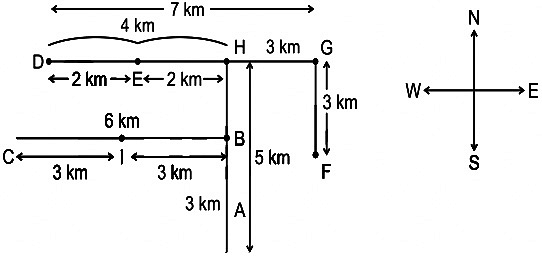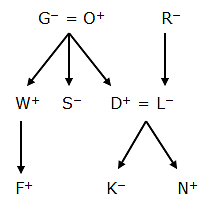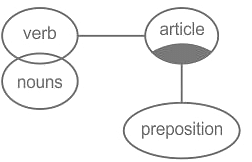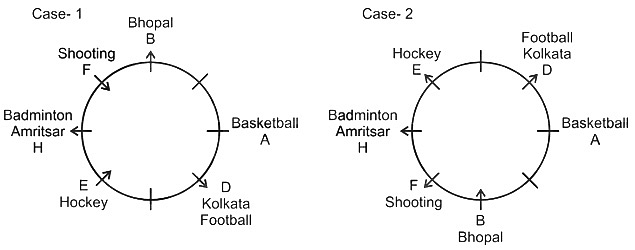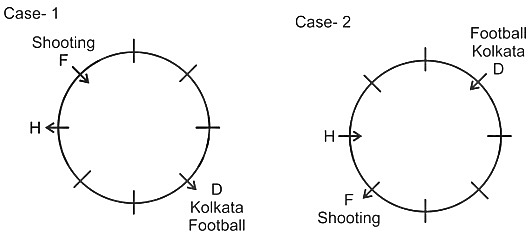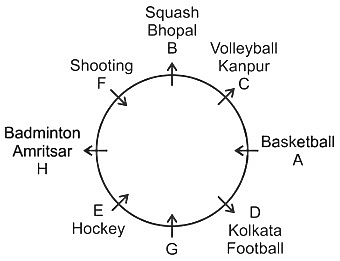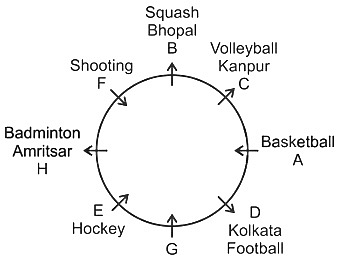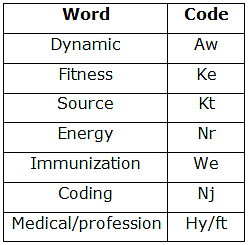RBI Assistant Mains Mock Test - 5 - Banking Exams MCQ
30 Questions MCQ Test - RBI Assistant Mains Mock Test - 5
Direction: Study the information given below carefully and answer the question that follow.
Nine friends A, B, C, D, E, F, G, H, and I lives at a certain distance from each other. C is 6 km West of B. A is 3 km South of B and H is 5 km north of A. G is 3 km East of H while D is 7 km West of G and F is 3 km South of G. I is situated just in middle of B and C while E is just in middle of H and D.
Distance between E and G is?
Directions: Study the following information carefully to answer the given questions:
E 4 W 2 G 6 @ S 5 8 X A ! I M 9 & Q ^ J L # 7 * C $ G V % K
How many such vowels are there in the above arrangement, each of which is immediately preceded by a symbol and immediately followed by a consonant?
| 1 Crore+ students have signed up on EduRev. Have you? Download the App |
Directions: Study the following information carefully to answer the given questions:
E 4 W 2 G 6 @ S 5 8 X A ! I M 9 & Q ^ J L # 7 * C $ G V % K
Which of the following is 8th to the right of 14th from the left end of the above arrangement?
Directions: Study the following information carefully to answer the given questions:
E 4 W 2 G 6 @ S 5 8 X A ! I M 9 & Q ^ J L # 7 * C $ G V % K
How many such symbols are there in the above arrangement each of which is immediately preceded by a number and followed by an alphabet?
Study the following information carefully and answer the questions given below.
Ten persons are there in the family with three generations and only two couples. The number of males and females are equal. Both the brothers of S are married and have children but only one sister-in-law is alive. L is the only daughter of R, who has two grandchildren. O is the father of S, who is the aunt of K. W, the son of O, is the father of F, who doesn’t have any siblings. D has two children of different gender, where N is one among them and the gender of both D and N are the same. L is the daughter-in-law of G but not the mother of F, who is of the opposite gender of K.
If F is married to Y, then how is Y related to R?
Study the following information carefully and answer the questions given below.
Ten persons are there in the family with three generations and only two couples. The number of males and females are equal. Both the brothers of S are married and have children but only one sister-in-law is alive. L is the only daughter of R, who has two grandchildren. O is the father of S, who is the aunt of K. W, the son of O, is the father of F, who doesn’t have any siblings. D has two children of different gender, where N is one among them and the gender of both D and N are the same. L is the daughter-in-law of G but not the mother of F, who is of the opposite gender of K.
Who among the following is the mother of K?
Study the following information carefully and answer the questions given below.
Ten persons are there in the family with three generations and only two couples. The number of males and females are equal. Both the brothers of S are married and have children but only one sister-in-law is alive. L is the only daughter of R, who has two grandchildren. O is the father of S, who is the aunt of K. W, the son of O, is the father of F, who doesn’t have any siblings. D has two children of different gender, where N is one among them and the gender of both D and N are the same. L is the daughter-in-law of G but not the mother of F, who is of the opposite gender of K.
How is W related to N?
Direction: Read the following information carefully and answer the questions that follow.
A & B means A is 5 km to the south of B.
A % B means A is 5 km to the east of B.
A + B means A is 1 km to the south of B.
A - B means A is 1 km to the east of B.
If it is given that: N % M; N - R - Q; O & Q; O + P. What is the distance between P and M?
Direction: Read the following information carefully and answer the questions that follow.
A & B means A is 5 km to the south of B.
A % B means A is 5 km to the east of B.
A + B means A is 1 km to the south of B.
A - B means A is 1 km to the east of B.
If it is given that: C + B % A; D + E - B. What is the distance between C and D?
Direction: Read the following information carefully and answer the questions that follow.
A & B means A is 5 km to the south of B.
A % B means A is 5 km to the east of B.
A + B means A is 1 km to the south of B.
A - B means A is 1 km to the east of B.
If it is given that: X - Y & A; X + Z + W - V; W % U. What is the direction of X with respect to U?
Direction: In the question below are given three statements followed by three conclusions numbered I, II and III. You have to take the given statements to be true even if they seem to be at variance with commonly known facts. Read all the conclusions and then decide which of the given conclusions logically follows from the given statements disregarding commonly known facts.
Statements:
I. All spoon is knife
II. No crockery is knife
III. Only a few spoon are cards
Conclusions:
I. Some spoon is crockery
II. Some cards are not knife
III. Some knife is not spoon
Direction: In the question below are given three statements followed by three conclusions numbered I, II and III. You have to take the given statements to be true even if they seem to be at variance with commonly known facts. Read all the conclusions and then decide which of the given conclusions logically follows from the given statements disregarding commonly known facts.
Statements:
I. No verb is article
II. Only a few nouns are verb
III. Some articles are not preposition
Conclusions:
I. Some prepositions are verbs
II. All verb is noun
III. Some article is noun
Direction: In the question below are given three statements followed by three conclusions numbered I, II and III. You have to take the given statements to be true even if they seem to be at variance with commonly known facts. Read all the conclusions and then decide which of the given conclusions logically follows from the given statements disregarding commonly known facts.
Statements:
I. All men are good
II. Some boys are bad
III. Only a few bad are good
Conclusions:
I. Some boys are not bad
II. Some men are good
III. Some bad are not good
Direction: In the question below are given three statements followed by three conclusions numbered I, II and III. You have to take the given statements to be true even if they seem to be at variance with commonly known facts. Read all the conclusions and then decide which of the given conclusions logically follows from the given statements disregarding commonly known facts.
Statements:
I. Some bacteria are virus
II. No virus is malaria
III. Only a few mosquito are bacteria
Conclusions:
I. No malaria is bacteria
II. Some virus is malaria
III. Some mosquito are not bacteria
Study the following information carefully and answer the questions given below.
Naveen and Nisha plans to meet at point H, for that both of them walks from different points. Nisha starts at point F and walks towards west for 4m and takes a right turn at point G. Then, she walks for 12m to reach point H and waits for Naveen to arrive. Later, Naveen starts at point A and walks towards north for 4m to reach point B, where he takes a right turn and walks 7m to reach point C. At point C, he takes a left turn for only 45 degrees and walks for 10m to reach point H, where he meets Nisha and then turns to his left and walks for 11m in west direction to reach point D and stops. Point G is exactly in the east of point A.
What is the direction of the starting point of Nisha with respect to the final point of Naveen?
Study the following information carefully and answer the questions given below.
Naveen and Nisha plans to meet at point H, for that both of them walks from different points. Nisha starts at point F and walks towards west for 4m and takes a right turn at point G. Then, she walks for 12m to reach point H and waits for Naveen to arrive. Later, Naveen starts at point A and walks towards north for 4m to reach point B, where he takes a right turn and walks 7m to reach point C. At point C, he takes a left turn for only 45 degrees and walks for 10m to reach point H, where he meets Nisha and then turns to his left and walks for 11m in west direction to reach point D and stops. Point G is exactly in the east of point A.
If Nisha waits at the point which is 4m to the north of point G, then how long does Naveen need to walk(total distance) to meet Nisha from point A?
Direction: Study the following information carefully and answer the questions based on it.
There are eight people A, B, C, D, E, F, G and H are seated around a circular table and among them some are facing away from the centre and some are facing the centre (not necessarily in the same order). They like different sports —Badminton, Football, Cricket, Basketball, Squash, Shooting, Hockey and Volleyball (not necessarily in the same order). They are also from different cities — Delhi, Kolkata, Amritsar, Bhopal, Rajkot, Chennai, Kanpur and Mumbai(not necessarily in the same order).
F sits opposite to D and likes Shooting. D, who belongs to Kolkata and likes Football, sits third to the left of H and both are facing the same direction. B sits immediate left of F and belongs to Bhopal. F and D both facing opposite direction to each other. A, who likes Basketball, sits second to the right of B but not adjacent to E. H, who belongs to Amritsar and likes Badminton, sits immediate and left and right of E and F respectively. The one who like squash and the one who like Volleyball are immediate neighbour of each other. The one who likes Hockey does not belong to Chennai. Neither G nor E likes volleyball. Not more than two person facing same directions are sitting together. The one who like Hockey sits immediate left of H. A does not like squash and Volleyball. G is not the immediate neighbour of A but face same direction with respect to A. C does not like squash but belongs to Kanpur. Equal number of persons are facing inside and outside directions. G belongs to Delhi and the one who like Basketball belongs to Rajkot. The one who likes Cricket and the one who likes Football are immediate neighbour.
Find the odd one out.
Direction: Study the following information carefully and answer the questions based on it.
There are eight people A, B, C, D, E, F, G and H are seated around a circular table and among them some are facing away from the centre and some are facing the centre (not necessarily in the same order). They like different sports —Badminton, Football, Cricket, Basketball, Squash, Shooting, Hockey and Volleyball (not necessarily in the same order). They are also from different cities — Delhi, Kolkata, Amritsar, Bhopal, Rajkot, Chennai, Kanpur and Mumbai(not necessarily in the same order).
F sits opposite to D and likes Shooting. D, who belongs to Kolkata and likes Football, sits third to the left of H and both are facing the same direction. B sits immediate left of F and belongs to Bhopal. F and D both facing opposite direction to each other. A, who likes Basketball, sits second to the right of B but not adjacent to E. H, who belongs to Amritsar and likes Badminton, sits immediate and left and right of E and F respectively. The one who like squash and the one who like Volleyball are immediate neighbour of each other. The one who likes Hockey does not belong to Chennai. Neither G nor E likes volleyball. Not more than two person facing same directions are sitting together. The one who like Hockey sits immediate left of H. A does not like squash and Volleyball. G is not the immediate neighbour of A but face same direction with respect to A. C does not like squash but belongs to Kanpur. Equal number of persons are facing inside and outside directions. G belongs to Delhi and the one who like Basketball belongs to Rajkot. The one who likes Cricket and the one who likes Football are immediate neighbour.
Four of the following five are alike in a certain way and so form a group. Which one does not belong to that group?
Direction: Study the following information carefully and answer the questions based on it.
There are eight people A, B, C, D, E, F, G and H are seated around a circular table and among them some are facing away from the centre and some are facing the centre (not necessarily in the same order). They like different sports —Badminton, Football, Cricket, Basketball, Squash, Shooting, Hockey and Volleyball (not necessarily in the same order). They are also from different cities — Delhi, Kolkata, Amritsar, Bhopal, Rajkot, Chennai, Kanpur and Mumbai(not necessarily in the same order).
F sits opposite to D and likes Shooting. D, who belongs to Kolkata and likes Football, sits third to the left of H and both are facing the same direction. B sits immediate left of F and belongs to Bhopal. F and D both facing opposite direction to each other. A, who likes Basketball, sits second to the right of B but not adjacent to E. H, who belongs to Amritsar and likes Badminton, sits immediate and left and right of E and F respectively. The one who like squash and the one who like Volleyball are immediate neighbour of each other. The one who likes Hockey does not belong to Chennai. Neither G nor E likes volleyball. Not more than two person facing same directions are sitting together. The one who like Hockey sits immediate left of H. A does not like squash and Volleyball. G is not the immediate neighbour of A but face same direction with respect to A. C does not like squash but belongs to Kanpur. Equal number of persons are facing inside and outside directions. G belongs to Delhi and the one who like Basketball belongs to Rajkot. The one who likes Cricket and the one who likes Football are immediate neighbour.
Which of the following statement is true?
Direction: Study the following information carefully and answer the questions based on it.
There are eight people A, B, C, D, E, F, G and H are seated around a circular table and among them some are facing away from the centre and some are facing the centre (not necessarily in the same order). They like different sports —Badminton, Football, Cricket, Basketball, Squash, Shooting, Hockey and Volleyball (not necessarily in the same order). They are also from different cities — Delhi, Kolkata, Amritsar, Bhopal, Rajkot, Chennai, Kanpur and Mumbai(not necessarily in the same order).
F sits opposite to D and likes Shooting. D, who belongs to Kolkata and likes Football, sits third to the left of H and both are facing the same direction. B sits immediate left of F and belongs to Bhopal. F and D both facing opposite direction to each other. A, who likes Basketball, sits second to the right of B but not adjacent to E. H, who belongs to Amritsar and likes Badminton, sits immediate and left and right of E and F respectively. The one who like squash and the one who like Volleyball are immediate neighbour of each other. The one who likes Hockey does not belong to Chennai. Neither G nor E likes volleyball. Not more than two person facing same directions are sitting together. The one who like Hockey sits immediate left of H. A does not like squash and Volleyball. G is not the immediate neighbour of A but face same direction with respect to A. C does not like squash but belongs to Kanpur. Equal number of persons are facing inside and outside directions. G belongs to Delhi and the one who like Basketball belongs to Rajkot. The one who likes Cricket and the one who likes Football are immediate neighbour.
Who sits third to the right of the one who likes Hockey?
Direction: Study the following information carefully and answer the questions based on it.
There are eight people A, B, C, D, E, F, G and H are seated around a circular table and among them some are facing away from the centre and some are facing the centre (not necessarily in the same order). They like different sports —Badminton, Football, Cricket, Basketball, Squash, Shooting, Hockey and Volleyball (not necessarily in the same order). They are also from different cities — Delhi, Kolkata, Amritsar, Bhopal, Rajkot, Chennai, Kanpur and Mumbai(not necessarily in the same order).
F sits opposite to D and likes Shooting. D, who belongs to Kolkata and likes Football, sits third to the left of H and both are facing the same direction. B sits immediate left of F and belongs to Bhopal. F and D both facing opposite direction to each other. A, who likes Basketball, sits second to the right of B but not adjacent to E. H, who belongs to Amritsar and likes Badminton, sits immediate and left and right of E and F respectively. The one who like squash and the one who like Volleyball are immediate neighbour of each other. The one who likes Hockey does not belong to Chennai. Neither G nor E likes volleyball. Not more than two person facing same directions are sitting together. The one who like Hockey sits immediate left of H. A does not like squash and Volleyball. G is not the immediate neighbour of A but face same direction with respect to A. C does not like squash but belongs to Kanpur. Equal number of persons are facing inside and outside directions. G belongs to Delhi and the one who like Basketball belongs to Rajkot. The one who likes Cricket and the one who likes Football are immediate neighbour.
Who sits opposite to the one who belongs to Rajkot?
Direction: What should come in place of the question mark '?' in the following number series?
4, 8, 10, 30, 33, 132, 136, 680, ?
Choose the number which is DIFFERENT from the rest.
Direction: What should come in place of the question mark '?' in the following number series?
120, 99, 80, ?, 48, 35
Study the following information carefully and answer the questions given below.
Given answers:
a) Only statement 1 alone is sufficient to answer the question
b) Only statement 2 alone is sufficient to answer the question
c) Either statement 1 alone or statement 2 alone is sufficient to answer the question
d) Neither statement 1 alone nor statement 2 alone is sufficient to answer the question
e) Both statement 1 and statement 2 together are sufficient to answer the question
Seven persons viz. R, S, T, U, V, W and X are living in a seven storey building such that the lowermost floor is numbered as 1 and the floor immediately above is numbered as 2 and so on, but not necessarily in the same order. Who among the following person lives at the bottom-most floor?
Statement 1: Only four persons live above V, who lives two floors below U. Neither T nor R lives in the floor adjacent to both U and V. At least two persons live between S and R. Equal number of persons live between U, T and V, W.
Statement 2: Three persons live between T and V, who lives immediately above W but neither in the top-most floor nor in the second floor. U lives immediately above S where neither of them lives adjacent to W and T, who lives immediately above X. S lives on an even numbered floor.
Study the following information carefully and answer the questions given below.
Given answers:
a) Only statement 1 alone is sufficient to answer the question
b) Only statement 2 alone is sufficient to answer the question
c) Either statement 1 alone or statement 2 alone is sufficient to answer the question
d) Neither statement 1 alone nor statement 2 alone is sufficient to answer the question
e) Both statement 1 and statement 2 together are sufficient to answer the question
Eleven persons are standing in a linear row such that all of them are facing towards north. Who among the following person stands second to the right of the one who stands fifth from the right end?
Statement 1: D stands fourth to the left of M, who stands second from the end. Five persons stand between M and L, who stands third to the right of G. Both K and J are immediate neighbors.
Statement 2: I stands third to the right of N, who stands to the immediate left of H. F stands to the right of L. Two persons stand between L and E, who is the immediate neighbor of D.
Study the following information carefully and answer the questions given below.
Given answers:
a) Only statement 1 alone is sufficient to answer the question
b) Only statement 2 alone is sufficient to answer the question
c) Either statement 1 alone or statement 2 alone is sufficient to answer the question
d) Neither statement 1 alone nor statement 2 alone is sufficient to answer the question
e) Both statement 1 and statement 2 together are sufficient to answer the question
What is the code for the phrase “Immunization energy” in the given code language?
Statement 1: In a certain code language, “Medical coding profession” is coded as “nj hy ft”; “Dynamic energy source” is coded as “aw kt nr”.
Statement 2: In a certain code language, “Dynamic fitness immunization” is coded as “we aw ke”; “Coding fitness source” is coded as “kt nj ke”.
Study the following information carefully and answer the questions given below.
“A&B” is written as “A is greater than B”
“A$B” is written as “A is smaller than B”
“A@B” is written as “A is either greater than or equal to B”
“A#B” is written as “A is either smaller than or equal to B”
“A%B” is written as “A is equal to B”
Given answers are:
a) Only I follows
b) Only II follows
c) Either I or II follows
d) Neither I nor II follows
e) Both I and II follow
Statements:
K # T $ U % D & V @ N & J; Z & W @ M % D & S
Conclusions:
I. Z & N
II. K $ M
Study the following information carefully and answer the questions given below.
“A&B” is written as “A is greater than B”
“A$B” is written as “A is smaller than B”
“A@B” is written as “A is either greater than or equal to B”
“A#B” is written as “A is either smaller than or equal to B”
“A%B” is written as “A is equal to B”
Given answers are:
a) Only I follows
b) Only II follows
c) Either I or II follows
d) Neither I nor II follows
e) Both I and II follow
Statements:
F & R $ T % U # Y % I; R % E @ W & C % N
Conclusions:
I. N # F
II. Y & W


